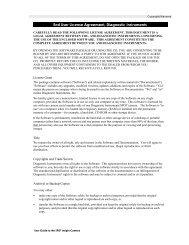optical interference filters - SPOT Imaging Solutions
optical interference filters - SPOT Imaging Solutions
optical interference filters - SPOT Imaging Solutions
You also want an ePaper? Increase the reach of your titles
YUMPU automatically turns print PDFs into web optimized ePapers that Google loves.
FLOW CYTOMETRY – DICHROIC FILTERS<br />
Dichroic <strong>filters</strong> must exhibit very steep cut-on edges to split off<br />
fluorescent signals that are in close spectral proximity. Specifying the reflection<br />
and transmission ranges of each dichroic in a multichannel system requires<br />
complete knowledge of all of the emission bands in the system and of their<br />
physical layout. Most often, obtaining optimal performance requires flexibility<br />
in the placement of the individual channels and the order in which the various<br />
signals are split off.<br />
Filter recommendations for a custom multicolor configuration require a complete<br />
understanding of the system. This includes the dyes that are to be detected, the laser<br />
sources that will be exciting the dyes, the simultaneity of laser firings, and the physical<br />
layout of the detection channels. With this information, optimum <strong>interference</strong> <strong>filters</strong><br />
can be selected that will provide the highest channel signal, the lowest excitation<br />
background, channel cross talk and the need for color correction.<br />
Since the emission spectra of fluorescent dyes tend to be spectrally wide, there is<br />
considerable spectral overlap between adjacent dyes. This becomes more the case<br />
as the number of channels is increased and the spectral distance between dyes is<br />
reduced. The result of this overlap is that the signal collected at a particular channel<br />
is a combination of the emission of the intended dye and emission contributions<br />
from adjacent dyes. Color compensation is required to subtract the unwanted signal<br />
contribution from adjacent dyes. Through our work with researchers in the flow<br />
cytometry community we have established specific band shape characteristics that<br />
Polarization is an important parameter in signal<br />
detection. In an <strong>optical</strong> instrument that utilizes a highly<br />
polarized light source such as a laser to generate<br />
signal in the form of both scatter and fluorescence,<br />
there will be polarization bias at the detector. Many<br />
factors such as the instrument’s light source, <strong>optical</strong><br />
layout, detector, mirrors and <strong>interference</strong> <strong>filters</strong> affect<br />
the degree of polarization bias.<br />
Dichroic mirrors are sensitive to polarization effects<br />
since they operate at off-normal angles of incidence.<br />
Omega Optical’s dichroics are designed to optimize<br />
steep transition edges for the best separation of closely<br />
spaced fluorophores, while minimizing the sensitivity<br />
to the polarization state of the incident energy.<br />
Note to Instrument Designers<br />
With laser sources, all of the output is linearly<br />
polarized. The dichroics’ performance will be<br />
different depending on the orientation of the lasers<br />
polarization. Omega Optical designs for minimum<br />
difference between polarization states, though it<br />
should be expected that the effective wavelength of<br />
the transition will vary by up to 10nm. Engineers at<br />
Omega Optical will gladly assist in discussing how to<br />
address this issue.<br />
minimize the need for color compensation. By creating narrower pass bands and placing them optimally on emission peaks, we have reduced<br />
the relative contribution of an adjacent dye to a channel’s signal, thereby producing a purer signal with less need for color compensation.<br />
Product SKU Application Description<br />
XCY-505DRLPXR<br />
Extended reflection longpass; Reflects 451 nm, 457 nm, 477 nm, 488<br />
nm and UV laser lines, Transmits > 525 nm.<br />
505DRLPXR<br />
100<br />
90<br />
80<br />
XCY-505DRLPXR<br />
XCY-560DRSP Shortpass; Separation of FITC from PE. 560DRSP<br />
XHC575DCLP Separation of Mithramycin from Ethidium Bromide. 575DCLP<br />
XCY-640DRLP Separation of APC from dyes with shorter wavelength. 640DRLP<br />
XCY-680DRLP Separation of PE-Cy5® and PE-Cy5.5. 680DRLP<br />
XCY-690DRLP Separation of APC from APC-Cy5.5® or APC-Cy7®. 690DRLP<br />
XCY-710DMLP Separation of PE and Cy5® from PE-Cy5.5® or PE-Cy7®. 710DMLP<br />
XCY-760DRLP Separation of Cy5.5® from Cy7® and their conjugates. 760DRLP<br />
Transmission (%)<br />
70<br />
60<br />
50<br />
40<br />
30<br />
20<br />
10<br />
0<br />
350 400 450 500 550 600<br />
Wavelength (nm)<br />
Specifications<br />
Size<br />
12.5, 15.8 and 25 mm<br />
Physical<br />
Thickness<br />
Shape<br />
< 6.7 mm<br />
Specify round and/or square<br />
Custom configurations available<br />
upon request<br />
Angle of Incidence Specify dichroic AOI 45° or 11.25°<br />
For current product listings, specifications, and pricing:<br />
www.omega<strong>filters</strong>.com • sales@omega<strong>filters</strong>.com<br />
1.866.488.1064 (toll free within USA only) • +1.802.254.2690 (outside USA)<br />
87

















